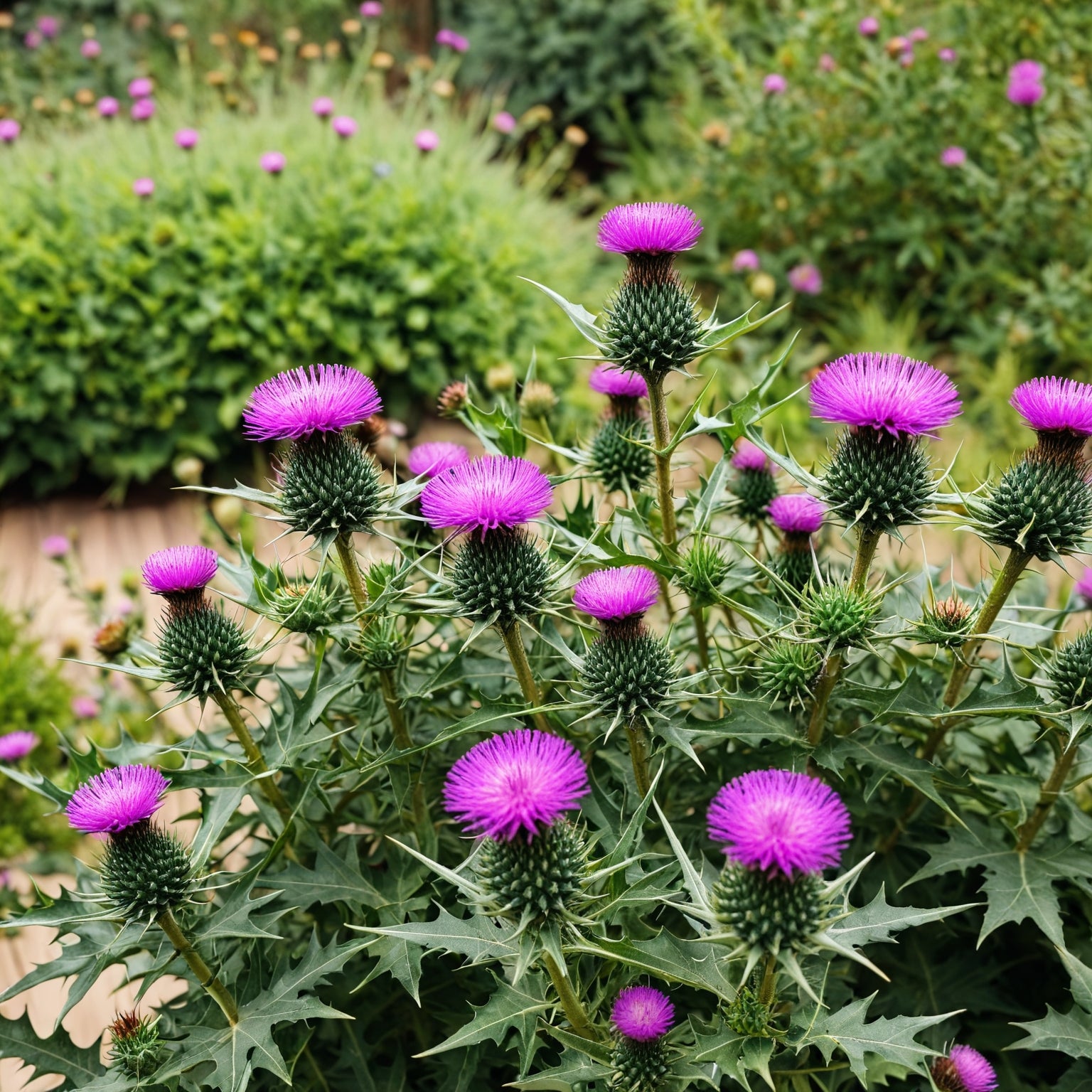- Hardiness Zone: 5-10 Biennial
- Hardiness Zone: 3-10 Can Be Grown As An Annual
Seed Depth: 1/4–1/2 inch
Seed Spacing: 18–24 inches
Row Spacing: 24–36 inches
Sunlight: Full sun
Days to Sprout: 10–21 days
Days to Maturity: 60–120 days (depending on the part of the plant harvested)
Growth Habit: Upright, bushy annual or biennial
Sunlight: Requires full sun, with at least 6–8 hours of direct sunlight daily.
Soil Type: Thrives in well-drained, sandy, or loamy soil with a pH of 6.0–7.5. Enrich with compost for better growth.
When to Plant: Sow seeds directly outdoors in early spring or late summer. Milk thistle is tolerant of cooler weather.
Direct Sowing: Plant seeds 1/4–1/2 inch deep, spacing them 18–24 inches apart in rows 24–36 inches apart.
Indoor Sowing: Start seeds indoors 4–6 weeks before the last frost and transplant seedlings when they are 4–6 inches tall.
Succession Planting: Not typically needed; plants self-seed and return yearly in suitable conditions.
Watering: Water deeply but infrequently, allowing the soil to dry out slightly between waterings. Milk thistle is drought-tolerant once established.
Fertilizing: Not typically required, but adding compost at planting can boost growth in poor soils.
Pruning: Remove spent flowers to prevent excessive self-seeding if control is desired.
Pest and Disease Control: Generally pest-resistant but monitor for aphids and fungal diseases. Use organic solutions if necessary.
When to Harvest: Harvest seeds when flower heads dry and fluff begins to form, typically 90–120 days after planting. Leaves can be harvested earlier for fresh use.
How to Harvest: Cut flower heads and allow them to dry completely before separating seeds. Use gloves to handle spiny plants.
Seed Collection: Once flower heads are dry, remove seeds and clean them of fluff and debris.
Storing Seeds: Store seeds in an airtight container in a cool, dry place.
Why You’ll Love It
Milk Thistle is a rugged, drought-tolerant heirloom herb with striking appearance and a long history of medicinal use. Its sharp, white-veined leaves form a dramatic rosette, topped by large, spiky purple flowers that attract bees and butterflies. Often used in herbal medicine to support liver function, this thistle is also great for adding visual interest to naturalized or pollinator-friendly gardens. Easy to grow in tough conditions, Milk Thistle thrives with minimal care.
Plant Characteristics
Height: 3–5 feet
Growth Habit: Upright and branching with bold, spiny foliage
Leaf Type: Large, glossy green leaves with white veins and spiny edges
Days to Maturity: 90–100 days
Hardiness: Annual to biennial; reseeds readily in zones 5–9
Flavor and Culinary Uses
Flavor: Slightly bitter and earthy
Culinary Uses: Traditionally harvested for its seeds, which are used in herbal teas or tinctures. Not typically used in cooking due to its spiny nature.
Companion Planting Tips
Good Companions: Echinacea, calendula, bee balm, and other pollinator-attracting herbs
Avoid Planting Near: Shallow-rooted vegetables — Milk Thistle is vigorous and needs space
Bonus Benefit: Excellent for pollinators and soil resilience — a striking addition to wildflower or herb meadows
Common Issues and Solutions
Invasive Spread: Deadhead flowers before seeds drop to prevent self-seeding if not desired
Spiny Foliage: Wear gloves when handling to avoid skin irritation
Poor Germination: Cold stratify seeds before planting to improve sprouting rates
Seeds Per Packet
| 1g | Approximately 40 |
| 3g | Approximately 120 |
| 5g | Approximately 200 |
| 7g | Approximately 280 |
Why You’ll Love It
Milk Thistle is a rugged, drought-tolerant heirloom herb with striking appearance and a long history of medicinal use. Its sharp, white-veined leaves form a dramatic rosette, topped by large, spiky purple flowers that attract bees and butterflies. Often used in herbal medicine to support liver function, this thistle is also great for adding visual interest to naturalized or pollinator-friendly gardens. Easy to grow in tough conditions, Milk Thistle thrives with minimal care.
Plant Characteristics
Height: 3–5 feet
Growth Habit: Upright and branching with bold, spiny foliage
Leaf Type: Large, glossy green leaves with white veins and spiny edges
Days to Maturity: 90–100 days
Hardiness: Annual to biennial; reseeds readily in zones 5–9
Flavor and Culinary Uses
Flavor: Slightly bitter and earthy
Culinary Uses: Traditionally harvested for its seeds, which are used in herbal teas or tinctures. Not typically used in cooking due to its spiny nature.
Companion Planting Tips
Good Companions: Echinacea, calendula, bee balm, and other pollinator-attracting herbs
Avoid Planting Near: Shallow-rooted vegetables — Milk Thistle is vigorous and needs space
Bonus Benefit: Excellent for pollinators and soil resilience — a striking addition to wildflower or herb meadows
Common Issues and Solutions
Invasive Spread: Deadhead flowers before seeds drop to prevent self-seeding if not desired
Spiny Foliage: Wear gloves when handling to avoid skin irritation
Poor Germination: Cold stratify seeds before planting to improve sprouting rates
Seeds Per Packet
| 1g | Approximately 40 |
| 3g | Approximately 120 |
| 5g | Approximately 200 |
| 7g | Approximately 280 |






Share and get 15% off!
Simply share this product on one of the following social networks and you will unlock 15% off!